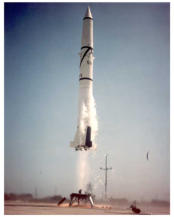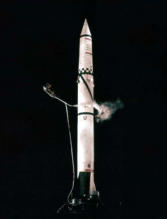
HISTORY - Page 1
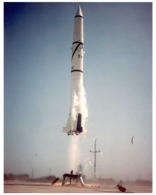

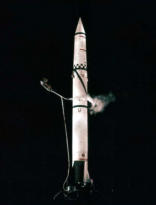

I. EVOLUTION TOWARD JUPITER DEVELOPMENT
In a sense, it is practically impossible to designate a point in time that could be
specified as the starting date for JUPITER planning. To have a missile weapon system
that could strike targets within the depth of theater operations was a prime goal of
battlefield commanders. Based on this criteria, planning for the development of a
long-range missile, or at least what would have been considered long-range in the
late Forties and early Fifties, could be said to mark the start. With this in mind, the
REDSTONE would be the immediate forerunner of the JUPITER, and logically so, for
many JUPITER components were sophistications of REDSTONE components.
At the outset, the REDSTONE program had a range objective of 500 nautical miles. As
time drew near to the actual "hardware cutting," however, the Office, Chief of
Ordnance (OCO) dictated a payload or war¬head weight that reduced the range to less
than 200 nautical miles with the power plants then available. This was in late 1950
when development of the REDSTONE was started. Although the Army Field Forces
(AFF) were now given promise of a missile weapon system with a thermo-nuclear
capability, the range was less than desired, and the REDSTONE became an interim
measure to attain at least a short-range capability. A long- range system was still
needed, and this thought was constantly in the minds of many planners. For a while,
the thinking was directed toward gaining the additional range through component redesign of the
REDSTONE. In fact, one such proposal in February 1954







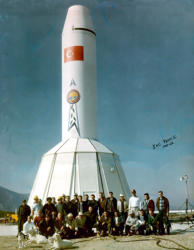
Jupiter SM-78 Weapon System
I&C Team 2, Çigli AB, Turkey 1961-1962 Chrysler Corporation Missile Division
HISTORY - Page 1
I. EVOLUTION TOWARD JUPITER DEVELOPMENT
In a sense, it is practically
impossible to designate a
point in time that could be
specified as the starting date
for JUPITER planning. To have
a missile weapon system that
could strike targets within the
depth of theater operations
was a prime goal of battlefield
commanders. Based on this criteria, planning for the
development of a long-range missile, or at least what
would have been considered long-range in the late
Forties and early Fifties, could be said to mark the
start. With this in mind, the REDSTONE would be the
immediate forerunner of the JUPITER, and logically
so, for many JUPITER components were
sophistications of REDSTONE components.
At the outset, the REDSTONE
program had a range objective
of 500 nautical miles. As time
drew near to the actual
"hardware cutting," however,
the Office, Chief of Ordnance
(OCO) dictated a payload or
war¬head weight that reduced
the range to less than 200
nautical miles with the power plants then available.
This was in late 1950 when development of the
REDSTONE was started. Although the Army Field
Forces (AFF) were now given promise of a missile
weapon system with a thermo-nuclear capability, the
range was less than desired, and the REDSTONE
became an interim measure to attain at least a
short-range capability. A long- range system was still
needed, and this thought was constantly in the
minds of many planners. For a while, the thinking
was directed toward gaining the additional range
through component redesign of the REDSTONE. In
fact, one such proposal in February 1954
